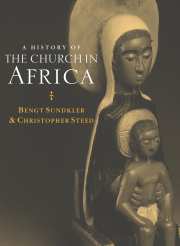Book contents
- Frontmatter
- Contents
- List of maps
- Acknowledgements
- List of abbreviations
- Introduction
- PART I THE FIRST FOURTEEN HUNDRED YEARS
- PART II THE MIDDLE AGES 1415 – 1787
- PART III THE LONG NINETEENTH CENTURY 1787 – 1919
- 3 Overview To The Nineteenth Century
- 4 North and North-Eastern Africa
- 5 Western Africa
- 6 West-Central Africa
- 7 Southern Africa
- 8 South-Central Africa and the Indian Ocean
- 9 East Africa
- 10 East-Central Africa
- PART IV THE COLONIAL EXPERIENCE 1920 – 1959
- PART V INDEPENDENT AFRICA 1960 – 92
- Notes
- Bibliography
- Name index
- Subject index
4 - North and North-Eastern Africa
from PART III - THE LONG NINETEENTH CENTURY 1787 – 1919
Published online by Cambridge University Press: 16 September 2009
- Frontmatter
- Contents
- List of maps
- Acknowledgements
- List of abbreviations
- Introduction
- PART I THE FIRST FOURTEEN HUNDRED YEARS
- PART II THE MIDDLE AGES 1415 – 1787
- PART III THE LONG NINETEENTH CENTURY 1787 – 1919
- 3 Overview To The Nineteenth Century
- 4 North and North-Eastern Africa
- 5 Western Africa
- 6 West-Central Africa
- 7 Southern Africa
- 8 South-Central Africa and the Indian Ocean
- 9 East Africa
- 10 East-Central Africa
- PART IV THE COLONIAL EXPERIENCE 1920 – 1959
- PART V INDEPENDENT AFRICA 1960 – 92
- Notes
- Bibliography
- Name index
- Subject index
Summary
Egypt
Slowly but surely the once almighty Ottoman empire was crumbling. From Istanbul the Turks had dominated the Muslim world for centuries, from Egypt with its bey to Algeria and its dey, all in principle with their populations subject to the Sultan in Istanbul.
‘The non-Muslims in the countries of Islam’ is a good title for a book Near Eastern Christian Churches, and might well have served as a title for this part of the chapter dealing with the Christian Churches in Egypt. Fattal's formula, focusing on the legal status of religious minorities, emphasizes something fundamental about the role of the Copts in Muslim Egypt: a minority in a staunchly Muslim country. Egypt's population today numbers 50 million, 82 per cent of whom are Muslims; the Copts together with the tiny Greek-Orthodox, Uniate Catholics, Anglicans and other Protestant communities make up only 18 per cent of the total population.
The political scene
The reveille of the nineteenth century in Egypt was sounded by foreigners. Napoleon Bonaparte occupied the country in 1798, although not for long for in 1801 his troops were defeated by combined British and Turkish forces. However, the French occupation, brief though it was, had a wider significance. The shock of the European occupation of Egypt caused a new consciousness across the Islamic world, including also parts of Islamic sub-Saharan Africa. It had the unforeseen effect of bringing about a Muslim reawakening.
- Type
- Chapter
- Information
- A History of the Church in Africa , pp. 124 - 168Publisher: Cambridge University PressPrint publication year: 2000



